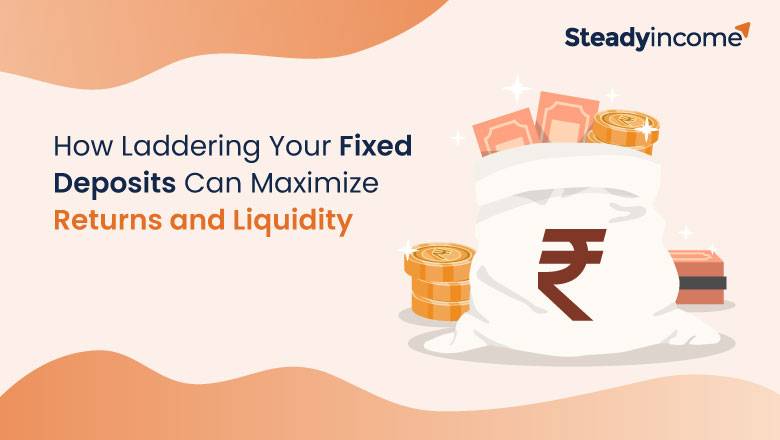How Laddering Your Fixed Deposits Can Maximize Returns and Liquidity

Fixed deposits (FDs) are one of the risk-averse investors' most popular investment options. They provide steady returns, capital safety, and predictable interest earnings. However, one common challenge with traditional FDs is the lock-in period, which restricts liquidity and flexibility.
Investors can use a fixed deposit laddering strategy. This method helps maximize both returns and liquidity while managing reinvestment risks effectively.
What is Fixed Deposit Laddering?
FD laddering is an investment strategy where you divide your total investment into multiple FDs with different maturity periods instead of investing in a single FD.
After the first FD matures in Year 2, you can reinvest it in a new 5-year FD at the current interest rate. The same process continues every year, ensuring a continuous cycle of liquidity and reinvestment.
Why Should You Use FD Laddering?
1. Higher Liquidity
With an FD ladder, one FD matures every year, ensuring you have access to funds without premature withdrawal penalties.
2. Better Interest Rate Management
Instead of locking your entire amount at one rate, laddering allows you to reinvest periodically at higher prevailing interest rates.
3. Reduced Reinvestment Risk
Interest rates fluctuate over time. Laddering ensures that only a portion of your investment is reinvested each year, reducing exposure to declining rates.
4. Flexibility to Adjust Strategy
You can modify your laddering approach based on changing financial goals, interest rates, or market conditions.
5. Avoid Premature Withdrawal Penalties
If you need funds urgently, a portion of your investment matures every year, avoiding premature withdrawal charges on long-term FDs.
Step-by-Step Guide to Implement FD Laddering
Step 1: Determine Your Investment Amount
Decide the total amount you want to invest in FDs. Let’s assume you have ₹5,00,000.
Step 2: Choose FD Tenures
Instead of putting all funds in a single FD, divide the amount equally into different FD tenures such as 1-year, 2-year, 3-year, 4-year, and 5-year deposits.
Step 3: Invest in Multiple FDs
Open separate FDs with different maturities. This ensures that every year, one FD matures and provides liquidity.
Step 4: Reinvest Maturing FDs
When the 1-year FD matures, reinvest it into a new 5-year FD at the prevailing interest rate. Continue this cycle for higher returns.
Step 5: Maintain Your FD Ladder
Monitor interest rate changes and adjust the strategy as needed. If rates rise, you benefit from higher reinvestment rates. If rates fall, your existing long-term FDs continue earning at higher locked-in rates.
Comparison: FD Laddering vs. Traditional FD Investment
When deciding between FD laddering and traditional FD investment, it's essential to understand their key differences in terms of liquidity, risk, returns, and flexibility.
1. Liquidity
Traditional fixed deposits have a fixed tenure, meaning your funds are locked in for the entire duration. If you need money before maturity, you might have to pay a penalty for early withdrawal. On the other hand, FD laddering ensures that a portion of your investment matures every year, giving you access to funds without penalties.
2. Interest Rate Risk
When you invest a lump sum in a single FD, the interest rate is locked in for the entire tenure. This means that if interest rates rise later, you miss out on better returns. With laddering, you reinvest maturing FDs at prevailing interest rates, reducing the impact of fluctuating rates.
3. Flexibility
Traditional FD investments do not offer much flexibility since all your money is locked for a single duration. FD laddering provides better financial control, allowing you to adjust your reinvestment strategy based on your goals or changes in the interest rate environment.
4. Premature Withdrawal
In a traditional FD, if you withdraw funds before maturity, you may lose a portion of your interest earnings due to premature withdrawal penalties. FD laddering eliminates this concern by ensuring you have annual liquidity, reducing the need to break an FD early.
5. Return Optimization
Since traditional FDs are invested at a single interest rate, they may not always offer the best long-term returns. FD laddering allows for staggered reinvestments, which helps you take advantage of higher interest rates over time, potentially increasing your overall earnings.
Best Practices for FD Laddering
✅ Choose Reliable Banks/NBFCs
Select banks or NBFCs with high credit ratings to ensure safety and stability of your deposits.
✅ Diversify Across Banks
To minimize risk, consider spreading your FD ladder across multiple financial institutions.
✅ Monitor Interest Rate Trends
Keep track of market interest rates and adjust your reinvestment strategy accordingly.
✅ Use Online FD Calculators
Online FD calculators help in estimating returns, interest earnings, and tax impact.
✅ Consider Taxation Impact
The interest earned on fixed deposits is subject to taxation under the category of "Income from Other Sources." If your interest income exceeds ₹40,000 (₹50,000 for senior citizens), TDS (Tax Deducted at Source) is applicable.
Who Should Use FD Laddering?
FD laddering is beneficial for:
-
- Salaried individuals seeking regular liquidity and stable returns.
- Retirees looking for a steady income without exposing capital to risk.
- Investors who prefer safety over market-linked investments like mutual funds or stocks.
- Individuals planning for future expenses like higher education, marriage, or home purchase.
Final Thoughts
Fixed deposit laddering is a smart investment strategy that helps you maximize returns, improve liquidity, and manage interest rate risks effectively. It allows you to enjoy higher flexibility while ensuring your money is working efficiently.
By implementing FD laddering, you can stay ahead of changing interest rates and secure financial stability without compromising on liquidity.
Start building your FD ladder today with Steadyincome, and enjoy optimized returns with better financial control!
Explore Fixed Deposit Investment Options at https://steadyincome.in/fixed-deposit


